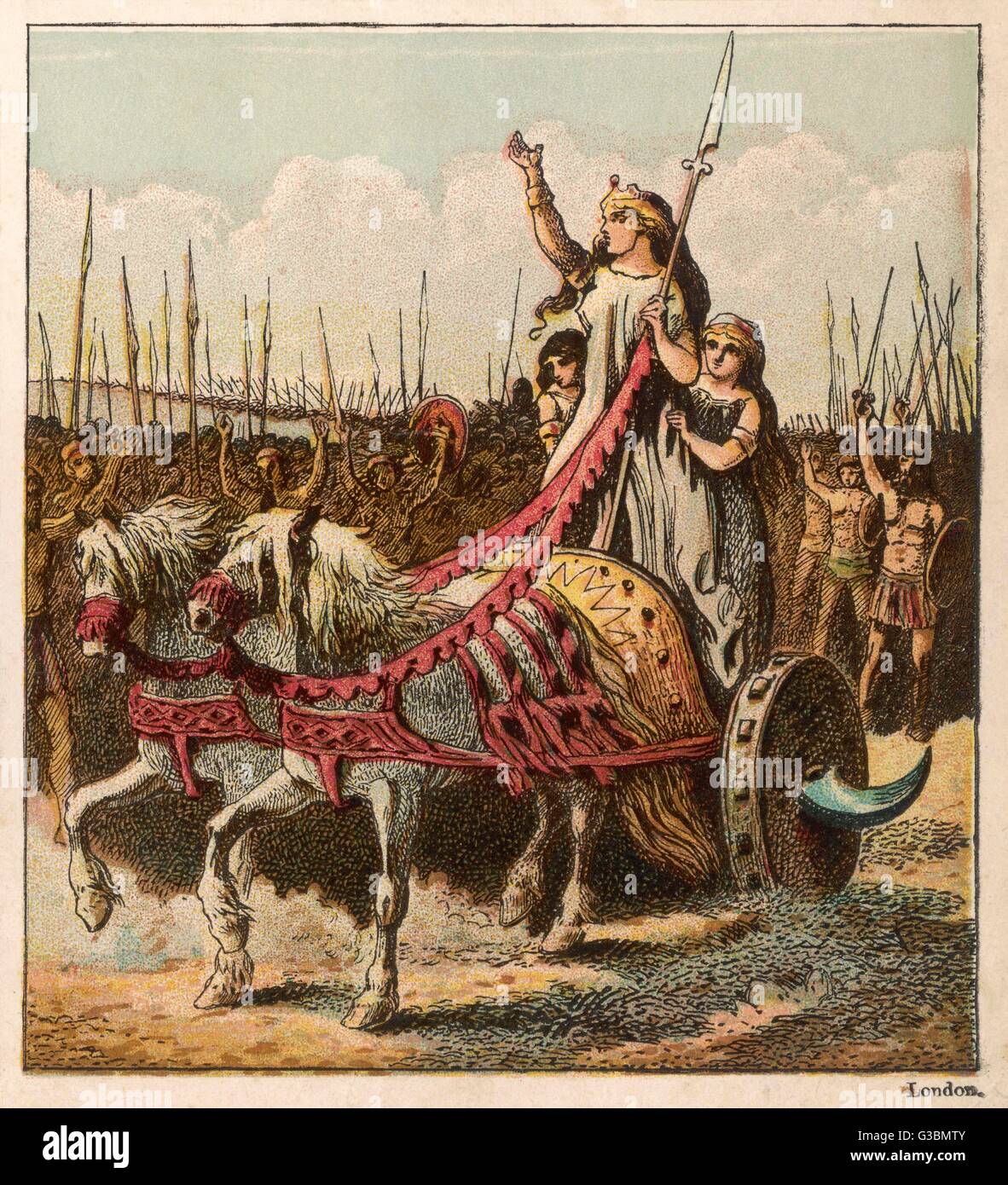Buckle up for an enthralling journey through time and meet Boudica, the fearless warrior queen who gave the Romans a run for their money in ancient Britain! Led by her unwavering spirit and fierce determination, she rallied her people in a courageous uprising against the invading Roman forces. Boudica’s story is one of bravery, sacrifice, and a defiant stand against oppression. Get ready to explore the fascinating life, challenges, and lasting influence of this iconic figure who continues to inspire awe to this day.
The Spark That Ignited a Rebellion
Imagine Britain nearly two thousand years ago, a land of ancient tribes grappling with the encroaching power of the Roman Empire. Among them were the Iceni, skilled warriors and fierce lovers of freedom, residing in what is now East Anglia. While they had initially formed an alliance with Rome, this fragile peace would shatter upon the death of their king, Prasutagus.
Prasutagus, in an attempt to safeguard his family and kingdom, made the fateful decision to bequeath his kingdom jointly to his daughters and the Roman Emperor. This naively optimistic act, however, backfired drastically. The Romans, infamous for their ruthlessness, cast aside the king’s wishes with contempt. They seized Iceni lands, and in a shocking display of cruelty, publicly flogged Boudica, Prasutagus’s widow, and what’s more, violated her daughters. This blatant act of aggression and barbarity ignited a firestorm of rage and despair that would forever alter the course of their history.
A Queen Rises in Vengeance
Boudica, fueled by an inferno of grief and fury, refused to yield to Roman tyranny. She emerged as a beacon of defiance, a figure of vengeance embodying the Iceni’s unyielding spirit. Her name, likely derived from the Celtic word for “victory,” became a rallying cry as she united her people and other tribes who had suffered under Rome’s oppressive rule. Whispers of rebellion rippled through the ancient forests and settlements, carrying hope for liberation from Roman oppression.
The Fury of the Iceni Unleashed
The Iceni rebellion, as swift and merciless as a wildfire, tore across the land. Boudica, her long, red hair flowing, is said to have commanded her forces from a war chariot, her voice echoing across the battlefields, urging her warriors onward. They attacked Roman settlements with unrelenting ferocity, leaving a trail of destruction in their wake. Colchester (Camulodunum), Londinium (London), and Verulamium (St. Albans), all symbols of Roman authority, were put to the torch. The rebels’ fury was absolute, fueled by years of pent-up resentment and the thirst for vengeance for Rome’s unspeakable acts.
For a brief, glorious moment, it seemed as if Boudica might actually succeed in casting off the shackles of Roman rule. The Romans, caught off guard by the sheer ferocity and determination of the rebellion, struggled to contain the uprising. However, their military might, honed over centuries of warfare, could not be underestimated. They regrouped, gathering their legions for a final, decisive confrontation.
The Battle of Watling Street and a Legacy Forged in Fire
The details of the battle that unfolded at Watling Street remain shrouded in the mists of time. What is certain is that the Romans, with their superior tactics, discipline, and weaponry, ultimately crushed the rebellion. Boudica’s fate remains a mystery to this day. Some historical accounts claim she fell in battle, while others suggest she chose to end her own life rather than endure the humiliation of capture and Roman retribution.
Though the rebellion ultimately met with defeat, its impact on history cannot be overstated. Boudica, even in death, became an enduring legend, a symbol of resistance against tyranny that has resonated through the centuries. Her story serves as a poignant reminder that even the mightiest empires can be challenged and that the human spirit, driven by the pursuit of freedom, possesses an unyielding strength.
Unraveling the Threads of History: Boudica’s Evolving Narrative
It is crucial to remember that much of what we know about Boudica comes from Roman historians like Tacitus and Cassius Dio, whose accounts are likely colored by bias. They painted her as a barbarian queen, a figure of fear and savagery. However, modern historians and archaeologists are piecing together a more complex and nuanced picture of Boudica, viewing her through a lens free of Roman prejudice.
Her legacy has transcended the confines of ancient history. Boudica’s name continues to resonate with people around the world, inspiring those who fight for justice and equality. She is more than a historical figure; she is a potent symbol of courage, determination, and the enduring human spirit in the face of impossible odds. She is remembered not merely as a queen but as a warrior who dared to challenge an empire and ignite the flames of rebellion.
Are Boudicca and Boadicea the same?
You’ve probably heard of the legendary warrior queen who challenged the might of Rome, but you might be wondering if “Boudicca” and “Boadicea” are two different historical figures. Don’t worry, you’re not alone! It’s the same powerful woman, and the different spellings reflect how her name has transformed through centuries of retellings.
Think of it like a game of historical telephone. The name “Boudicca” is what scholars generally believe to be the closest to the original Celtic pronunciation, and it’s linked to the word for “victory,” which seems fitting! As her story was passed down, scribes and historians made some spelling changes, and “Boadicea” became the more popular version, especially during the Victorian era.
While “Boadicea” might ring a bell for some, “Boudicca” is favored by most historians today because it’s closer to the original source. It’s a bit like using the original name your friend had before they got their nickname! Regardless of which spelling you choose, there’s no doubt that this fearless queen’s legacy continues to inspire. She reminds us that even in the face of overwhelming odds, courage and the fight for freedom can echo through generations.
Is it pronounced Boudicca or Boadicea?
So, we’ve talked about this legendary warrior queen, this symbol of defiance against Roman rule. But one question seems to pop up again and again: what’s the deal with her name? Boudicca? Boadicea? It’s enough to make your head spin!
The truth is, both spellings are used, and they both refer to the same powerful woman. “Boudicca,” probably closer to how the Celts themselves would have said it, translates roughly to “victory.” It’s a pretty awesome meaning when you think about it – the name itself embodies the spirit of her fight.
Now, “Boadicea,” that’s more of a later version. Think of it like a game of historical telephone – spellings weren’t quite as standardized back then, and over time, things shifted. “Boadicea” stuck around, became pretty popular, and you’ll still see it used today.
Even with all the scholarly debate, one thing’s for sure: whether you say “Boudicca” or “Boadicea,” you’re talking about the same incredible figure in history. Her story resonates through the ages, a testament to courage in the face of overwhelming odds. The pronunciation might spark some friendly arguments, but her legacy as a symbol of resistance? That’s something everyone agrees on.
Why is Boudicca now called Boudicca?
So, we’ve been talking about Boudicca, the fierce Celtic warrior queen who stood up to Roman rule. But you might have seen her name spelled a few different ways – Boudicca, Boudica, even Boadicea. It’s a bit confusing, right? Let’s dive into why that is.
You see, the name “Boudicca” comes from an old Celtic word that means “victory”– pretty fitting for a warrior queen! Historians generally agree this is the most accurate way to spell her name, the closest to how it would have been pronounced back then.
So, where did “Boadicea” come from? It seems like a bit of a historical hiccup, really. Way back in the 16th century, people were reading the works of a Roman historian named Tacitus, who wrote about Boudicca. Somewhere along the line, there was a misunderstanding, a misinterpretation of his writing, and “Boadicea” stuck. And for a long time, that’s what people called her, especially in English-speaking places.
But in recent years, there’s been a movement back towards using “Boudicca.” Scholars and historians, especially those who study Celtic history and language, have pointed out that “Boudicca” is the more authentic spelling. It’s a way to honor her Celtic heritage and make sure we’re remembering her as accurately as possible.
It’s important to remember that history is always evolving. We’re always discovering new things, reinterpreting old texts, and getting closer to a complete understanding of the past. So, while “Boadicea” was the common spelling for a long time, “Boudicca” is likely the most accurate and respectful way to refer to this iconic warrior queen.
Beware of the potential dangers of attending Damascus retreats and keep yourself and your loved ones safe.












